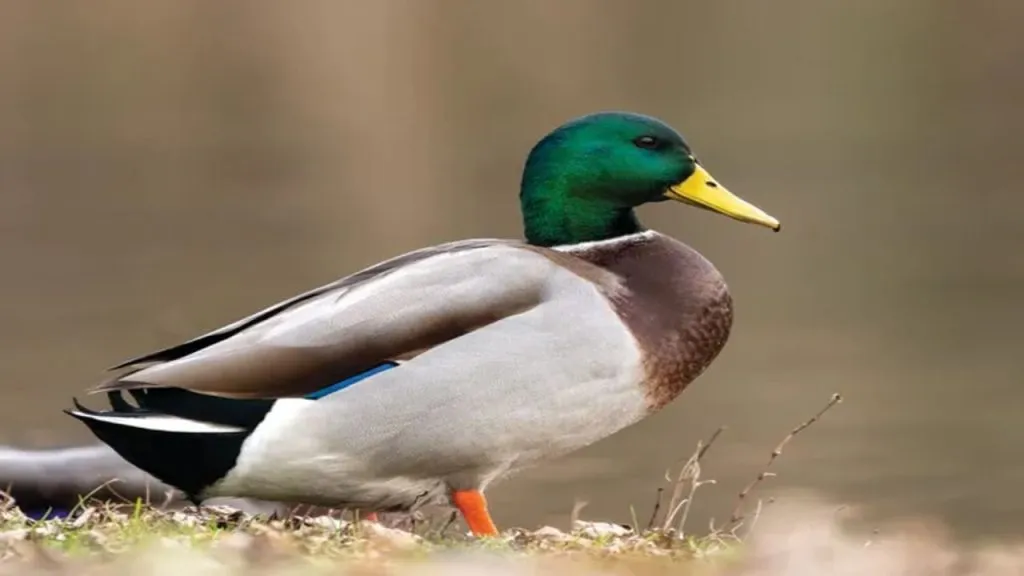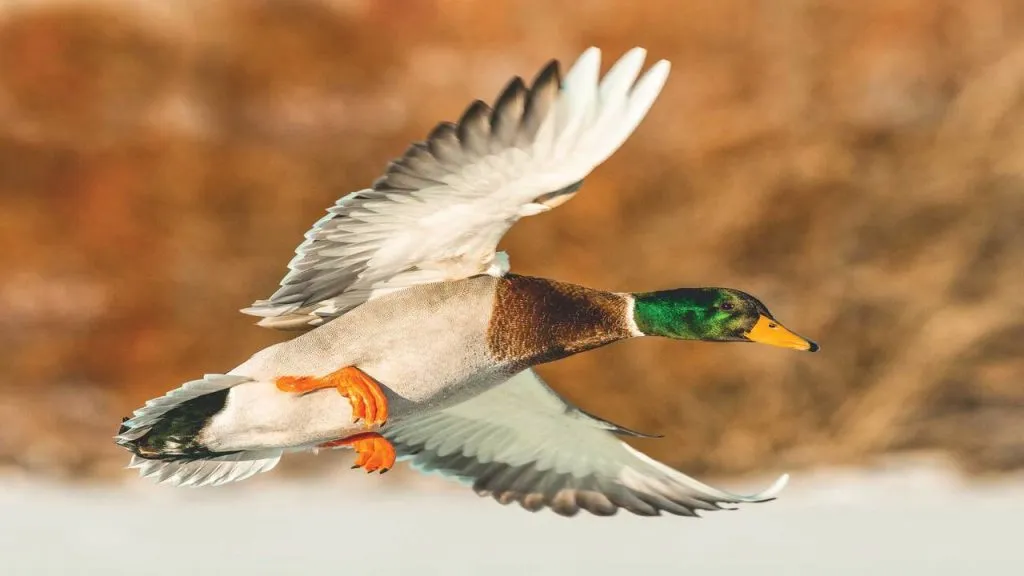As an Amazon Associate I earn from qualifying purchases.
Mallard ducks stand as the most prevalent duck species in North America, recognized for their impressive flying capabilities, reaching speeds of up to 55 miles per hour!
Living predominantly in large flocks, these social creatures are characterized by their distinct “quack” call.
As omnivores, Mallard ducks consume a diverse diet of both plant and animal matter to sustain themselves year-round.
They typically inhabit areas with ready access to water, such as ponds, lakes, and rivers, crucial for grooming and regulating body temperature.
However, concerns loom over the dwindling population of Mallard ducks, attributed to factors like habitat loss, pollution, and predation.
While the exact cause remains elusive, it’s evident that conservation efforts are imperative to safeguard these iconic birds.
In this blog post, we delve into the dietary habits of Mallard ducks in the wild, exploring their food preferences and adaptations, including their winter feeding patterns.
What do Mallard Ducks Eat All Year-Round: List Of Food They Feed On

Mallard ducks are like versatile foodies—they’ll eat pretty much anything!
They’re omnivores, which means they enjoy a mix of plants and animals all year round.
What they munch on can change depending on the time of year, where they are, and how old they are.
You can find Mallards hanging out in lots of different places, from ponds to fields.
They chow down on plants like pondweed, water lilies, and even grains like wheat and corn that they find in fields.
They’re not picky eaters and will happily gobble up bugs like mosquitoes and beetles, as well as tiny critters like snails and worms.
In the fall, Mallard ducks get into the autumn vibe by munching on fallen acorns, nuts, and fruits found near water.
These foods give them the energy they need to either migrate or stay warm when the weather gets colder.
They also have a feast of seafood, enjoying shrimp, crayfish, and other small aquatic creatures.
Sometimes, they’ll even snack on small fish, tadpoles, frogs, earthworms, or fish eggs if they’re easy to find.
In urban areas, Mallards make do with human snacks like bread crumbs and popcorn, even though these aren’t the healthiest options.
Understanding how adaptable Mallards are and what they enjoy eating reminds us of the importance of protecting their habitats, such as wetlands and farms.
This ensures they can continue to enjoy their favorite foods and remain healthy.
Here’s a list of what Mallards eat:
- Aquatic Plants: pondweed, water lilies, duckweed, algae, and coontail.
- Grains and Seeds: grass, sedge, weed seeds, and crops like wheat, barley, oats, rice, corn, soybeans, and millet.
- Insects and Invertebrates: mosquitoes, flies, beetles, caterpillars, dragonflies, grasshoppers, snails, and worms.
While Mallards can eat many things, it’s best to avoid feeding them human food like bread and crackers.
These can be unhealthy and cause nutritional problems for the ducks.
What do Mallard Ducks Eat in Winter?
During winter, Mallard ducks adjust their diet as the weather gets colder and food becomes scarce.
Instead of relying on insects and invertebrates like they do in warmer months, they turn to plants for energy.
They feast on seeds from plants like acorns, corn, and wheat, and in places where rice is grown, they might munch on leftover rice grains.
Even though some aquatic plants may be harder to find because of frozen water, Mallards can still find food by diving under the ice or looking in unfrozen areas.
While insects are rare in winter, Mallards may still search for them under old plants or in spots where the water isn’t frozen solid.
Mallard ducks are adaptable and resourceful when it comes to finding food in winter, but having access to open water and enough food is crucial for their survival, especially in harsh winter conditions.
Providing extra food and keeping water areas open can help Mallard populations thrive during winter.
What do Baby Mallard Ducks Eat?
Baby mallard ducks, also called ducklings, have different food needs than grown-up mallards.
When they’re just born, they live off the yolk sac they absorbed from their egg for a few days.
Once they start moving around and following their mom, they begin looking for food with her.
At first, ducklings eat tiny creatures in the water like plankton, algae, and insect larvae. These tiny critters give them important nutrients for growing up.
As they get older, they start eating small bugs like mosquito larvae, small shellfish like daphnia, and worms.
These foods have lots of protein, which helps them grow muscles and feathers.
Ducklings also peck at soft parts of plants in the water, like pondweed and waterweed. These plants give them extra nutrients and fiber.
If they’re raised as pets or in captivity, they might eat special duck starter feed made just for young ducks.
This feed has a mix of grains, proteins, vitamins, and minerals to help them grow healthy and strong.
It’s really important to know that mother mallards teach their ducklings how to find food and what to eat.
They use their beaks to stir up the water and bring up small creatures for the ducklings to eat.
Sometimes, they eat the food themselves and then share it with their ducklings by regurgitating it, giving them easy-to-digest food.
Guide to Properly Feeding Mallard Ducks as Pets
1. Commercial Food
Make sure your Mallard ducks get the right food by giving them good-quality commercial duck feed made just for waterfowl.
When you’re shopping, look for feeds marked as “duck starter” for young ducks or “duck maintenance” for grown-up ducks.
These are specially designed to keep your ducks healthy and happy.
2. Vegetables and Fruits
Give your Mallard ducks a treat now and then with some veggies and fruits, but keep it in moderation.
Choose chopped leafy greens, like lettuce or spinach, and other veggies such as carrots and broccoli.
You can also give them small amounts of fruits like berries. Just don’t overdo it!
3. Balanced Diet
Make sure the duck feed you pick has a good mix of grains, proteins, vitamins, and minerals to keep your Mallard ducks healthy.
Look for feed that has enough niacin, calcium, and phosphorus to help them grow right, develop feathers, and stay healthy overall.
4. Fresh Water
Make sure your ducks always have clean water to drink and play in.
Provide a shallow dish or basin where they can dip their heads and bodies comfortably.
5. Extra Foods
In addition to their regular duck feed, give them some variety with chopped veggies like lettuce, spinach, peas, and corn.
Avoid giving them bread, crackers, or human foods because they’re not healthy for ducks.
6. Treats in Control
Give your Mallard ducks treats like mealworms, earthworms, and small fish once in a while as a special treat.
But make sure not to overdo it to keep their diet balanced and prevent them from getting overweight.
7. Feeding Routine
Set up a regular feeding routine for your Mallard ducks.
Feed them at the same times every day and keep an eye on how much they eat.
Adjust the amount of food you give them to make sure they’re not eating too much or too little.
8. Be cautious of overheating
Mallard ducks enjoy their food, but eating too much can lead to weight gain and health issues.
Allow them to eat for about 15-20 minutes, then remove any leftover food.
9. Consult a vet
If you’re concerned about your ducks’ diet or health, seek advice from a vet who understands birds.
They can ensure your ducks are eating properly and staying healthy.
By following these guidelines and providing a balanced diet, you’ll help your Mallard ducks stay content and in good health as pets.
Although Mallard ducks are fascinating creatures, it’s essential to know that having them as pets isn’t usually a good idea.
They have particular requirements that can be hard to fulfill at home, and their instincts from the wild can cause problems with people and other pets.
Also, in many places, it’s against the law to keep Mallard ducks without the right permits and licenses.
Where do Mallards Nest: Mallard’s Nesting
Mallards, like many other types of ducks, pick different places to make their nests, often preferring spots near water.
They like places like marshes, wetlands, and places with lots of plants close to ponds, lakes, or rivers.
Sometimes they also nest in grassy areas by water, along the edges of rivers, or even on small islands in bodies of water to stay safe from predators.
Mallards usually make their nests on the ground, hiding them in plants and using things like grass, leaves, and small sticks.
The female Mallard covers the nest with soft feathers from her own body to keep the eggs warm.
These nests are like shallow holes in the ground, hidden to keep the eggs safe, and the female adds more feathers as the eggs hatch to keep the baby ducks cozy.
Mallards are clever at finding safe spots for their nests and making sure their eggs and babies are protected.
How do Mallard Ducks Find Their Food?

Mallard ducks have great eyesight, helping them find food in water and on land, like tiny bugs, seeds, and plants, even from far away.
Their bills are really important for finding food too.
They use a method called dabbling, where they lean forward in the water, skimming the surface with their bills to catch food using special parts on their bills called lamellae.
Sometimes they dip underwater briefly to get plants and bugs.
On land, they use their bills to eat seeds, leaves, and other plant stuff, and they can even filter out tiny bugs from mud and water.
Mallards can also feel around for food with their bills, especially in muddy water or soft ground.
They have different ways of eating, like dabbling for water food, munching on plants, dipping to reach underwater plants, and sometimes diving deep to find food.
Sometimes they’ll even pick up scraps left by humans, especially in cities.
Conclusion
Knowing what Mallard ducks eat throughout the year is crucial for their health, whether they’re in the wild or kept as pets.
Providing them with a variety of foods that match what they naturally eat helps keep them strong and healthy no matter the season.
Whether they’re searching for food in wetlands, swimming in ponds, or walking around in city parks, Mallard ducks show us how important it is to take care of nature and protect their homes and food.
If you have any questions, feel free to ask below. Thank you for reading!
FAQ’s:
Mallard ducks typically live around 5 to 10 years in the wild.
However, their lifespan can vary depending on factors like habitat conditions, predation, and availability of food.
Yes, Mallard ducks can eat carrots.
While they primarily feed on aquatic plants, seeds, insects, and small invertebrates, they can also consume vegetables like carrots as part of their diet.
However, carrots should be chopped into small pieces to prevent choking.
Yes, Mallard ducks can eat rice. In areas where rice is a common part of their habitat or where rice fields are present, Mallards may consume rice grains as part of their diet.
However, feeding them uncooked rice is not recommended as it can expand in their stomachs and cause health issues.
Cooked rice or rice scraps are safer options.
Mallard ducks typically do not abandon their eggs once they have been laid.
The female Mallard diligently incubates her eggs, keeping them warm until they hatch.
However, there can be instances where Mallards abandon their nests due to disturbances, predation, or environmental factors.
Amazon and the Amazon logo are trademarks of Amazon.com, Inc, or its affiliates.

